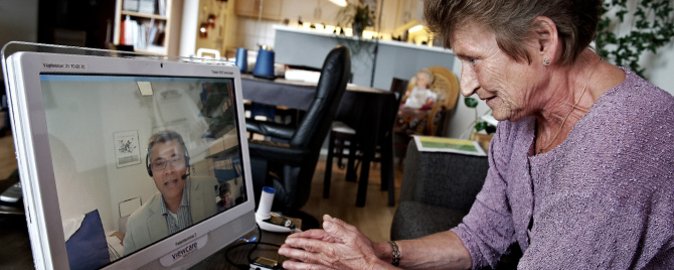- Education
-
Research
Current research
Talent
-
Collaboration
Businesses
Government agencies and institutions
Alumni
-
About AU
Organisation
Job at AU
For new telemedicine solutions to be successful, users must be involved in the development of ideas and design. This is the opinion of one of the world’s leading experts in the field – Professor and Head of Research Morten Kyng, Centre for Pervasive Healthcare, Aarhus University. A new platform for telemedicine is being established at Aarhus University.
2014.02.14 |

[Translate to English:] Virtuelle konsultationer kan blive en vigtig del af fremtidens sundhedsvæsen. Men brugerne skal være med til at forme teknologien. Foto: Mikkel Khan Tariq
“For telemedicine solutions to be successful, technology users and experts need to be brought together. In Aarhus, we’re among the world leaders regarding user-driven innovation and participatory design,” says Professor and Head of Research Morten Kyng, Director of the Centre for Pervasive Healthcare at Aarhus University. Here he carries out research into what is known in Denmark as ‘omnipresent health IT’, and he works in fields such as developing telemedicine prototypes (‘gizmos’) and concepts.
Users must design
Telemedicine is about delivering IT-based health solutions independent of time, location and space. It is often highlighted as one of the answers to the global challenge of the increasing elderly population. However, research at institutions such as Aarhus University shows that new technology in this area rarely provides a solution in itself. Users must be involved in the design process.
“That which is called ‘participatory design’ is very important for success – especially in health IT. It doesn’t matter how good the technique is if users can’t use the product for one reason or another, or if they don’t like it or feel the equipment spoils their home,” says Professor Kyng.
New Aarhus University platform
This is one of the reasons that Aarhus University has set up a platform that invites both researchers and external operators to discuss and familiarise themselves with innovative, user-driven telemedicine solutions.
The researchers work in areas ranging from Engineering and Medicine to Anthropology and Information Studies, and they collaborate with both the Central Denmark Region and private companies.
“And we’d like to find more to people to work with in Denmark and abroad,” says Finn Olesen.
The telemedicine platform is the project with the highest priority at Aarhus University in the Danish Ministry of Higher Education and Science’s INNO+ strategy. INNO+ is the inspiration and prioritisation catalogue for strategic investments in innovation, and was launched in spring 2013.
New contacts
Associate Professor Finn Olesen is a technology philosopher and one of the driving forces behind the platform. He sees great innovation potential in telemedicine when different players join forces, as is the case in Aarhus right now.
“The point is that, during the innovation process, we have to draw on everything from knowledge of Technology and Medicine to knowledge of Economics, Arts and Anthropology. And we have to be in touch with companies and decision-makers. No matter how clever we researchers are, we won’t get any further unless businesspeople, politicians and users can envisage the ideas themselves and want to contribute personally,” says Professor Olesen.
He looks forward to the new platform creating contact between people who would otherwise never have met each other.
“We can possibly help them to open a company’s eyes to what it means to get an anthropologist involved in development work, for example. An anthropologist knows something about user experiences, and it could just be that this person can point out precisely what would get the user or patient to like the company’s product,” he says.
Examples of telemedicine
Self-monitoring with IT-based resources: Patients with chronic diseases can be offered web-based resources and possibly measuring equipment to record their condition and clinical values.
Telerehabilitation: Instructions in physical exercises from physiotherapists, for example. Can also include virtual consultation and virtual training sessions.
Telecare surveillance: Monitoring elderly or handicapped citizens and their homes via equipment such as sensors on the body or in the home.
Teleinterpretation: Assistance from interpreters via a webcam and screen in connection with consultations in a ward or health centre.